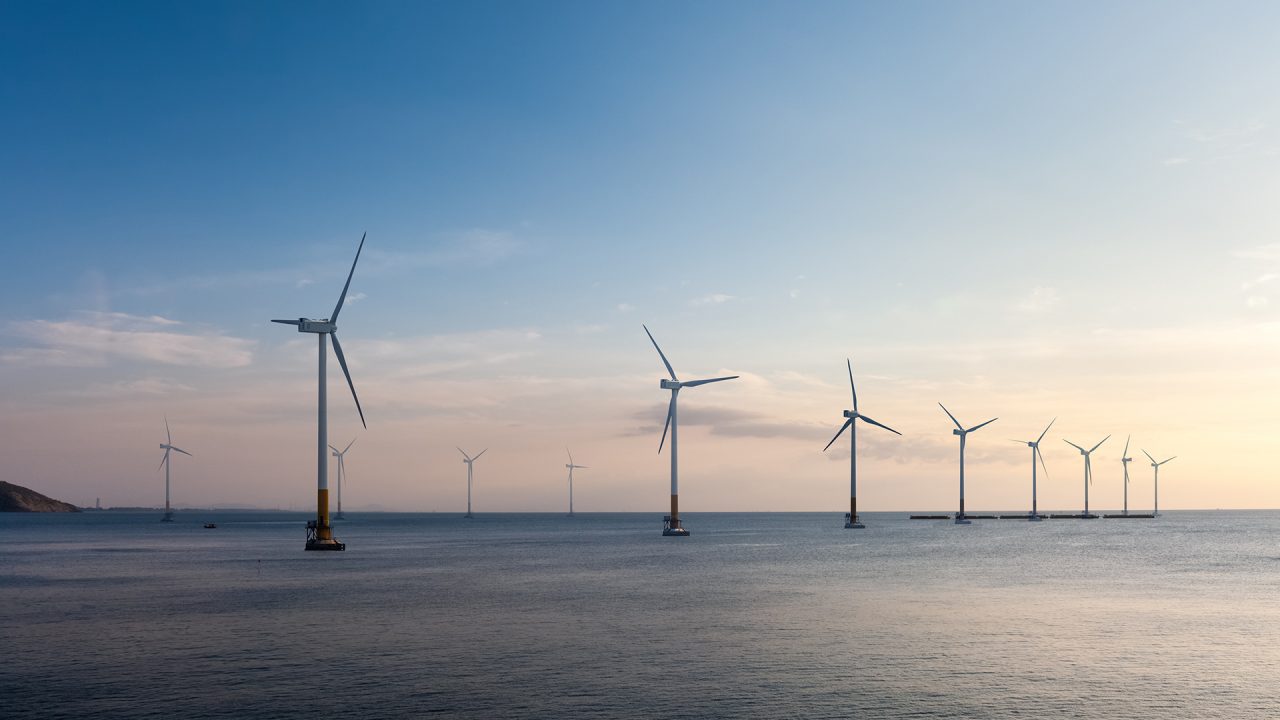

Offshore wind
03 December 2020
Offshore wind energy is reshaping local industries and revitalising economies across Asia. Green Investment Group (GIG) is at the forefront of this fast-growing market. We were an early mover into the region, acting as the lead developer in Taiwan’s first commercial scale offshore wind farm, Formosa 1; in South Korea, we are leading the way with next generation technologies, originating a floating offshore wind project pipeline with a potential capacity of c. 2.3 GW with our partner Total; while in Japan, we are co-developing a 3.3 GW offshore wind portfolio with our partner Iberdrola. In total, we have c. 8 GW of offshore wind capacity in development across the region.
Taiwan
Taiwan is one of the most prominent offshore wind markets in Asia, driven by the Government’s ambitious renewable energy policies.
Oil, coal-fire and liquefied natural gas have historically accounted for the largest share of Taiwan’s power supply, with renewable energy accounting only for 5% in 20174. However, Taiwan has set targets to reduce its greenhouse gas emissions to 50% by 20505 and increase the share of renewable energy in its power supply to 20% by 2025.
In 2019, the market’s investment in offshore wind projects totalled US$7.8 billion6. Domestic players in the turbine supply chain are partnering with global turbine suppliers, such as Siemens Gamesa (SGRE) and MHI Vestas, to enable the transfer of skills and benefit of cost reductions which have already been achieved. SGRE recently announced plans to create a regional offshore wind nacelle industrial hub in Taiwan, MHI Vestas has established its Asia headquarter in Taiwan7.
Formosa: Taiwan’s leading offshore wind portfolio
In Taiwan, GIG and partners have been developing the Formosa offshore wind portfolio – three projects with a combined capacity of up to 2.5 GW.
The first, and the only, commercial scale operational offshore wind farm in the market with 128 MW capacity, powering the equivalent of up to 128,000 Taiwan homes.
F2 is expected to be one of only three operational windfarms in Taiwan by 2021. The 376 MW project reached financial close in October 2019 and is now under construction.
F3 comprises three offshore wind farm sites located in Changhua county on the central-western coast of Taiwan, with a combined potential installed capacity of up to 2 GW.
Learn more about the Formosa offshore wind portfolio.
South Korea
South Korea is currently the fourth largest coal importer in the world. Fossil fuel energy accounts for nearly two-thirds of the country’s electricity generation, while nuclear power accounts for the bulk of the remaining third8.
However, the South Korean Government’s RE3020 plan targets an aggressive increase in green power generation goals, from 8-9% to 20% of generation by 2030 and 30-35% by 2040. The country’s “New Green Deal” aims to create jobs in the sector while transforming Korea into one of the world's top five offshore wind energy powerhouses9 through the installation of 12 GW of offshore wind by 2030.
Korea is surrounded by deep waters, making it a suitable location for floating offshore wind projects. While floating offshore wind remains a relatively new technology, 1.2 GW of capacity is expected to be built by 203010. With that growth in capacity comes the potential for significant cost reductions.
One of the main challenges to achieving those cost reductions lies in the industrialisation of the technology. With its state-of-the-art shipyards, manufacturing facilities, maritime expertise and port facilities, South Korea is uniquely placed to tackle this challenge.
Floating offshore wind in Ulsan
GIG’s project in Ulsan, south-east of Korea, is the largest floating offshore wind proposition in the country, with 1.5 GW under development. A wind measurement campaign is underway at the site, and development activities for the first 500 MW phase are targeted for completion by 2023.
GIG deployed South Korea's first and only commercial floating LiDAR system to collect wind data.
The Ulsan floating offshore wind project is being co-developed by Total.
GIG is the only foreign company on the board of the Korea Wind Energy Industry Association (KWEIA) and holds the position of vice-chair. Through KWEIA we actively advise the National Assembly, government and relevant authorities on offshore wind regulations and policies.
Learn more about the Ulsan floating offshore wind project.
Japan
The Fukushima Daiichi Nuclear Power Station accident in 2011 shifted the country’s interest away from nuclear power, towards alternative sources of energy.
In October 2020, Japan joined the growing number of countries pledging to become carbon neutral by 205011.
As an island country, Japan has a large sea area and long coastline, which offers significant potential for offshore wind development. These geographic conditions underpin the country’s ambitions to expand its installed offshore wind capacity to 10 GW by 2030 and 30 – 45 GW by 204012.
To facilitate the delivery of these targets, under the Renewable Energy Use Law enacted in 2018, the government will designate Promotional Zones for offshore wind projects annually. These zones have been identified as being free from existing fishing and shipping activities, and have naturally occurring conditions favorable to offshore wind farms.
From the risks posed by earthquakes and tsunamis, to the desire to grow a domestic supply chain and transfer skills from a well-established, industrial workforce, Japan’s offshore wind market bears many of the same development characteristics found across Asia.
By working across the region, GIG is able to combine global experience with local expertise to deliver world-class outcomes.
Looking ahead: 3.3 GW offshore wind portfolio
We recently announced our partnership with Iberdrola to co-develop a 3.3 GW portfolio of six offshore wind projects, both fixed bottom and floating, in Japan.
Learn more about the partnership.
Footnotes